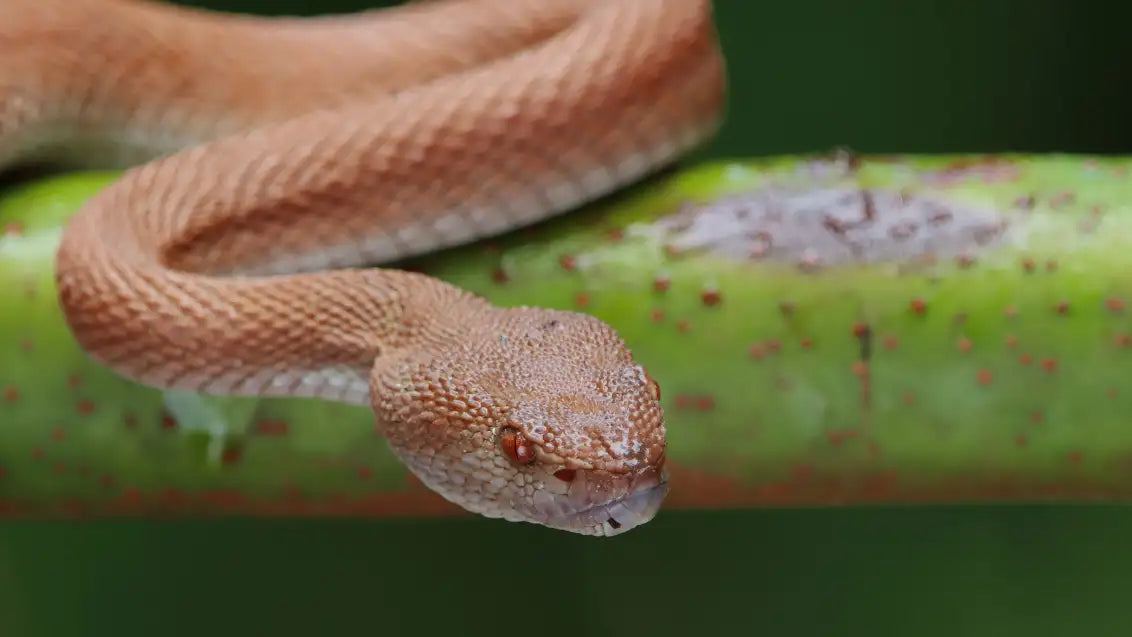
How to tell if a snake is poisonous? - All about snakes!
Snake, the creature whose presence evokes both dread and awe among people. Dread for its venomous and constricting nature whereas awe for its slithering movements and beautiful patterns. Whenever we encounter this predatory creature, the first question that rings in our mind is: “Is it poisonous?”
To ease our perplexing thoughts regarding snakes and their identification, we are here with the guide “How to tell if a snake is poisonous? - All about snakes!”. So without any further ado, let’s find out the traits of venomous and non-venomous snakes.
What does a snake symbolize?

Snakes represent various symbols across different cultures. When snakes shed their skin, they are related to transformation and rebirth. They are also seen as wise creatures that represent enlightenment. In some cultures, snakes symbolize danger, deceit, and temptation whereas snakes represent strength, adaptability, and other protective qualities in others.
All about snakes
Snake’s body structure

A snake’s body is known for its flexibility and it is due to this that people often wonder “do snakes have bones”, some even conclude that snakes are boneless creatures which is wrong.
- The skeleton of snakes is made of a skull, a long spine, and hundreds of ribs.
- Their bodies are covered with scales and these scales are made of keratin.
- Their jaws are joined with stretchy ligaments that help them open their mouth wide and swallow their prey.
- Their organs are elongated and only their right lung is functioning.
- Some snakes have excellent vision while others rely completely on heat-sensing pits to find warm-blooded animals.
What do snakes eat?

Do snakes need daily food?
Snakes do not need daily food as they can go for longer periods without eating. The frequency of eating food depends on their species, size, age, and activity level.
Young snakes - Provide food every 5 to 7 days
Adult snakes - Need food every 1 to 2 weeks.
Large snakes - They can go without food for weeks and even months if they eat a large prey.
What do snakes eat in the wild?
Snakes eat the following:
- Mice
- Rabbits
- Squirrels
- Chicks
- Bird eggs
- Frogs
- Lizards
- Toad
- Small fish
- Beetles
- Grasshoppers
- Snails
How long do snakes live?

A snake's lifespan is affected by its environment, predators, diseases, and other environmental changes.
| Small Snakes | Medium Sized Snake | Large Snake |
| Small sized snakes like Garter and corn have a lifespan of 5 to 10 years in the wild. | King snakes, ball pythons, and rat snakes can live from 10 to 20 years in captivity whereas 8 to 12 years in the wild. | Large snakes can live from 20 to 30 years in captivity but in the wilds, snakes like boa constrictors, anacondas, and reticulated pythons can live up to 10-15 years. |
How do snakes move?

Snakes have a common movement where they form an “S” shape while moving. Some other movements are concertina movement, sidewinding, and rectilinear motion. To move, snakes completely rely on their powerful muscles and belly scales to grip surfaces and create forward momentum.
Where do snakes live?
Snakes are adaptable creatures that live in forests, deserts, grasslands, wetlands, oceans, mountains, and even urban areas.
How to tell if a snake is poisonous OR How to tell if snake is venomous?

Poisonous and venomous are two different terms used to describe the presence of dangerous substances in animals. Venomous refers to animals that inject venom into their prey through bites or stings whereas poisonous refers to the animals that release toxins when touched or eaten.
Most venomous snake (Most poisonous snake)

1. Vipers
Vipers are known for their fangs and venom. They belong to the Viperidae family and are found in Asia and Africa. Russell viper, Gaboon viper, and Saw scaled viper are some viper snakes known for their fangs, and venomous bite.
2. Cobras, Kraits, and Coral Snakes
King cobra (largest poisonous snake), Indian cobra, Black mamba, Banded krait, and eastern coral snake, these snakes have fixed fangs. They are known for their neurotoxic venom. These snakes are found in Asia, Africa, and America.
3. Sea Snakes
The sea snakes are fully aquatic, and found in coral reefs and tropical oceans. Some sea snakes are Olive sea snakes and yellow-bellied sea snakes. The sea snakes belong to the Hydrophiinae family.
4. Rattlesnakes
Rattlesnakes are a group of pit vipers known for the rattle at the end of their tails. The rattlesnakes are found in the southeastern US and the deserts of North America. The eastern diamond rattlesnakes and western diamond rattlesnakes are some examples.
5. Adders
Adders are short snakes found in Africa, Europe, and Asia. These snakes belong to the Viperdae family. The puff adder is an example of a snake known for its venom.
6. Taipans
Taipans, snakes that belong to the Elapidae family are the most venomous snakes. They are found in Australia and Papua New Guinea. Known for their speed, precision, and venom, these snakes are predators that use camouflage to capture prey.
7. Death Adders
The snakes use their tail to lure their prey. Death Adders can live in different habitats but are commonly found in Australia. These snakes are not aggressive but they strike quickly. Their venom is neurotoxic , it can affect the nervous system and cause paralysis.
Other Venomous Snakes:
- Black Mamba
- Bushmaster
- Olive Sea Snake
- Copperhead
- Coral Snake
- Boomslang
- Fer-de-Lance
Non venomous snakes (Non poisonous snakes)

1. Boas
Boas are the non venomous snakes found in America, Africa, Madagascar, and some Pacific islands. These snakes belong to the Boidae family and their size can vary from 1 meter to 9 meter. Boas have flexible jaws, smooth scales, and muscular bodies.
2. Pythons
The fascinating snake of the Pythonidae family has various species like the Reticulated Python, Burmese Python, Ball Python, African Rock Python, Green Tree Python, and Indian Python. Pythons are constrictors and can suffocate their prey. These reptiles have unhinged jaws that allow them to eat prey much larger than their head.
3. Rat Snakes
The snakes are not just excellent climbers but a beneficial part of the ecosystem. These snakes help control the population of rodents, Rat snakes can vibrate their tails to mimic a rattlesnake. They are found in forests, grasslands, wetlands, and urban areas.
4. Garter Snakes
Gartan, the garden snakes are known for their non aggressive nature and unique defense mechanisms of releasing a foul-smelling musk to deter predators. These snakes can survive in colder climates by hibernating.
5. Kingsnakes
These snakes with beautiful patterns including banded, striped, speckled, and solid are found from southern Canada to South America. The kingsnakes can eat other venomous snakes such as rattlesnakes, copperheads, and coral snakes.
6. Milk Snakes
Milk in the name of these snakes is not related to their coloration or dietary habits but originated from an old myth in which it was believed, they enter barns and drink milk from cows. These snakes are nocturnal and due to their docile nature, these snakes make popular pets.
7. Water Snakes
Water snakes are non venomous creatures who are active during the day. They are excellent swimmers and ambush their prey underwater or on water edges. They help control the population of fish and other amphibians.
Other Non venomous Snakes:
- Corn snake
- Green snake
- Hognose snake
- Western worm snake
- Eastern ribbon snake
- Gopher snake
- Vine snake
How to tell if snake is venomous?

- Head: Venomous snakes have wide and triangular heads because of their venom glands. The venom glands are located behind the eyes of snakes. The non venomous snakes have a rounded head as they do not possess the venom glands.
- Pupil: The pupils of non venomous snakes are round whereas the pupils of venomous snakes are vertical, and their pupils are similar to a cat's.
- Fangs: Venomous snakes have long and hollow fangs. Their fangs are retractable. Non venomous snakes have smaller and nonhollow teeth used for gripping prey.
- Tail Type: The tail of a venomous snake is thicker in comparison to non poisonous snake. Some snakes have a rattle at the end of the tail.
- Snout: The venomous snakes have triangular snouts while non venomous snakes have rounded snouts.
Custom Snake art
|
Summing Up!
To sum up, we can identify venomous snakes by understanding their traits. However, it is important to observe them from a safe distance and avoid making assumptions. Stay safe and respect these fascinating creatures.
Check out Pets by Numbers to create beautiful snake paintings!

